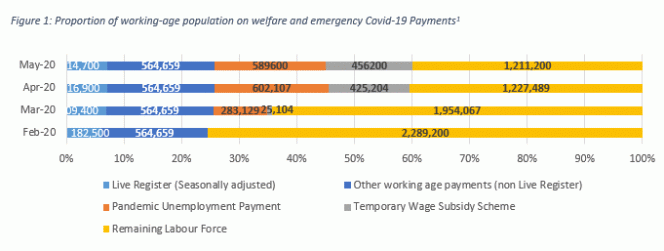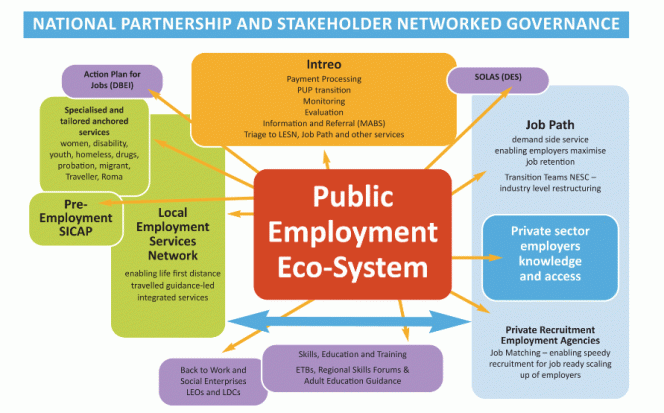Ten Steps on a High Road Covid Era Back to Work Strategy
Toggle
In the space of just a few weeks, Covid-19 has fundamentally reconfigured the relationship between welfare and work in Ireland. The shock to global patterns of production and consumption not seen since the Great Depression resulted in unprecedented levels of job-loss in Ireland and elsewhere. Pre Covid-19, there were already too many unemployed on the Live Register while over half a million working age adults were depending on other inadequate income supports for their daily survival. While the focus now, understandably, is getting people back to work as quickly as possible we need to remember that many people are not job ready and require significant support to return to work, while also living in relative poverty. In fact nearly 1.8m people or almost 60 percent of the labour force are depending on state income.
Figure 1: Proportion of working-age population on welfare and emergency Covid-19 Payment(1)

We need to avoid returning to a ‘normal’ that did not work for many people. Rather, we need to develop the most appropriate model of activation for this unique Covid-19 era. Poorly designed activation programmes, which tend to over-rely on conditionality and sanctions, are harmful, but good quality, well-designed and enabling supports can help people regain employment. While much of the immediate government response to Covid-19 has been through income supports, we cannot rely only on passive measures (2).
We need active support to help people get back as quickly as possible to decent jobs. Active Labour Market Policies (ALMPs) (including public employment services, guidance, job and skill matching, short and long term training, job creation programmes, wage subsides and in-work benefits) are a necessary part of the Covid-19 response. Many people may be traumatised; sudden unemployment has psychological impacts, and renders our mental health is more vulnerable. We need to find effective ways of creatively and supportively enabling people to be confident about going back to work safely in the context of social distancing, and also help unemployed people find a decent job in this changing context. We need therefore a ‘High Road’ recovery that leaves no one behind. We can do this by following ten steps or action points:
- 1. Activate all available resources through an enabling Public Employment Eco-System (Fig 2), develop an integrated Back to Work strategy for a High Road and Inclusive Recovery
- 2. Develop a ‘careful and hopeful’ empoyment service. It is crucial to prevent long term unemployment. Those considered ‘job ready’ need a ‘decent work first’ approach that recognizes people need post-trauma support. A capability approach will enable speedy recruitment into decent sustainable jobs.
- 3. To leave no one behind it is essential to proactively include those who have not benefited from previous recoveries, including the long term unemployed. A work-life approach for those more distant from the labour market requires a tailored and guided approach, delivered through local employment partnerships.
- 4. The Temporary Wage Subsidy (TWS) offers an important point of contact with employers for developing demand-side supports linked to employment quality and equality policy objectives, as well as strategies to upgrade Ireland’s indigenous low paid procurement can fuel local economies.
- 5. Policy has to target both the low paid and those left behind, including the long term unemployed. Those who have lost jobs are most likely to be young, women, or migrant workers, and more likely to be low paid workers who are renting and vulnerable. The ‘low-learning trap’ that constitutes low-skilled workers in indigenous, small-to-medium enterprises can be tackled through a skills and education strategy for low paid workers. A targeted service for those most distant from the labour market has to meet the differentiated needs of those experiencing particular barriers (homelessness, addiction, criminal records) and discrimination (gender, lone parents, age (younger and older people), ethnicity, and disability).
- 6. Institutions need to be reoriented into a Public Employment Eco-System comprised of public, private and not-for-profit organisations who co-operate through networked governance and collaboration rather than marketization.
- 7. Co-production, a key steering mechanism underpinning the model of network governance, recognises that citizens and service users are integral policy actors and is based around inter-agency and cross-sectoral collaboration, with local employment partnership delivery crucial.
- 8. Digitalisation and online service delivery platforms are key to expanding and reforming activation services but significant levels of digital exclusion can also create new digital divides. While digital services are necessary, both quality and equality is assured through human focused employment services including triaging, needs/strength assessment and case management.
- 9. Creative use of income supports can enable transition back to work. There remain outstanding issues of adequacy and conditionality in non-Covid Working Age payments. Stigma should be avoided by enabling participation in socially valued activity, including care and part-time work.
- 10. Covid-19 has reminded us of the importance of essential public services. A strategy of Universal Basic Services is needed to ensure access to health, housing, childcare, employment guidance and other public services. Precarious workers’ lives are more precarious without access to such services, while withdrawal of these services should not cause unemployment or poverty traps.
Fig 2 A future Public Employment Eco-System for a capability led High Road Covid era recovery.

The 10 steps here are expanded in the report The ‘High Road’ Back to Work: Developing a Public Employment Eco-System for a Covid Era Recovery, co-authored by Murphy M.P., Whelan N., McGann M. and Finn P. It is published by the IRC supported ACA PES ‘A Collaborative Approach to Public Employment Services’, an IRC Coalesce funded research project based in Maynooth University. An advisory committee including ILDN, LESN, INOU collaborate to support the research. For more details, please contact [email protected] or [email protected].
